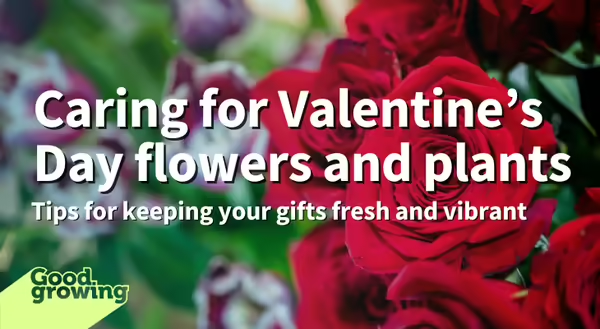
Valentine's Day is a time for expressing love and appreciation for others, often by giving cut flowers and, increasingly, potted plants. Whether you've received a bouquet of flowers or a potted plant, here are some tips that can help you care for them to keep them healthy and attractive as long as possible.
Caring for cut flowers
According to the Society of American Florists, Valentine's Day is the number one holiday for florists and floral purchases, with an estimated 250 million roses being produced. While roses are the most popular cut flower given on Valentine's Day, a variety of other flowers, such as tulips, carnations, and lilies, are also gifted. Cut flowers can often be enjoyed for a week or more with proper care.
- Start by cleaning the vase where the flowers will be placed, especially if it has been previously used. Use warm, soapy water to wash the vase, and rinse it well to remove any soap residue. Washing will help remove any bacteria present, which can shorten the lifespan of cut flowers.
- Remove any foliage that will be submerged in water. These leaves can quickly decay and lead to bacterial growth, which will shorten the vase life of the flowers.
- Cut off the bottom ½-1 inch of the flower stems at a 45-degree angle using scissors or a knife. This will increase the surface area for water absorption and help the flowers stay hydrated.
- Fill the vase with fresh water and add the flower preservative that often comes with the bouquet. The preservatives usually contain sugar, an acidifying agent, and an anti-microbial compound, which will help increase the life of the flowers and work better than homemade concoctions.
- Place flowers in a cool, brightly lit area. Avoid direct sun, drafty areas, and heat sources (heating vents, appliances, etc.), which can shorten the life of the flowers.
- Check water levels daily and add water as needed. Change the water if it becomes cloudy or starts to smell, and add more floral preservative. Remove flowers as they begin to fade and wilt.
Caring for Valentine's potted plants
Potted plants can be just as stunning as a bouquet of flowers, with the added advantage of lasting for months or even years with proper care. While a variety of different plants are gifted on Valentine's Day, some popular potted plants include miniature roses, orchids, and succulents.
Miniature roses
Miniature roses have been bred to be smaller and more compact than traditional roses, with smaller flowers, leaves, and shorter stems. They typically grow 1 to 2 feet tall (some, the micro-minis, only grow to be 6 inches), making them perfect for growing in pots.
Miniature roses need at least 6 hours of direct sunlight; south and west-facing windows are usually the best option. They can be grown under artificial lights if direct sunlight cannot be provided. Keep soil moist, watering when the soil surface feels dry. Plants can be fertilized with a dilute fertilizer once or twice a month. Deadhead flowers as they begin to fade. Plants can be moved outdoors in spring once the danger of frost has passed. Miniature roses are hardy plants and can be planted in the ground in a sunny location or kept in their pots and brought back indoors in the fall.
Orchids
Orchids sold at florists and box stores are tropical epiphytes (usually Phalaenopsis). These plants don't grow in soil and often grow on trees in their native range. Because they don't grow in soil, they get their water and nutrients from the air, rain, and any organic debris that may accumulate around them.
Phalaenopsis orchids grow best in bright, indirect light. They prefer warm temperatures (70 to 80° F) during the day and slightly cooler temperatures at night (60 to 70 ° F). They also need relatively humid conditions (40-60% humidity), which can be difficult to reach indoors, especially during the winter. Placing the plant on a tray filled with pebbles and water, grouping plants, or running a humidifier can help increase the humidity around them. Water orchids when their growing media gets dry until water runs out of the pot.
Succulents
Succulents, like kalanchoe, crassula, echeveria, Senecio, and tender sedums, have become increasingly popular houseplants in the last several years, and their popularity has extended into Valentine's Day.
Succulents will do best in a window that receives bright indirect sunlight for at least 6 hours a day (the more, the better). Without adequate light, succulents will begin to stretch, and colorful succulents may revert to green. Artificial lighting can also be used. Most succulents will do well in typical home conditions, preferring temperatures from 55°F to 75°F and low humidity.
The number one killer of succulents is probably over-watering. Wet the entire root ball when watering, but don't let the plants sit in water for more than a few hours. Let the soil dry between waterings. Depending on growing conditions, plants may only need to be watered every few weeks.
Good Growing Tip of the Week: When cutting flower stems, use a sharp knife, scissors, or pruners to avoid crushing the stems. Crushed stems won't be able to take up water as well, leading to a shorter vase life.
Want to get notified when new Good Growing posts are available? SIGN ME UP!
Give us feedback! How helpful was this information (click one): Very helpful | Somewhat helpful | Not very helpful
MEET THE AUTHOR
Ken Johnson is a Horticulture Educator with University of Illinois Extension, serving Calhoun, Cass, Greene, Morgan, and Scott counties since 2013. Ken provides horticulture programming with an emphasis on fruit and vegetable production, pest management, and beneficial insects. Through his programming, he aims to increase backyard food production and foster a greater appreciation of insects